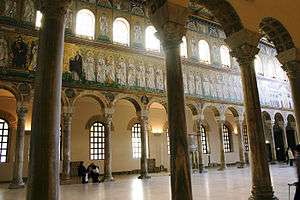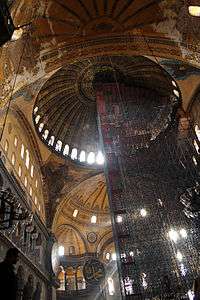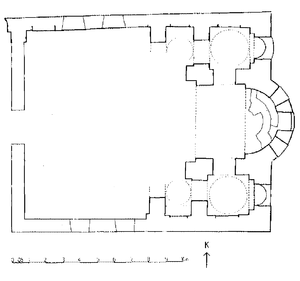Byzantine architecture
Byzantine architecture is the architecture of the Byzantine Empire, also known as the Later Roman or Eastern Roman Empire. This terminology is used by modern historians to designate the medieval Roman Empire as it evolved as a distinct artistic and cultural entity centered on the new capital of Constantinople rather than the city of Rome and environs. The empire endured for more than a millennium, dramatically influencing Medieval architecture throughout Europe and the Near East, and becoming the primary progenitor of the Renaissance and Ottoman architectural traditions that followed its collapse.
Overview of extant monuments
Early Byzantine architecture drew upon earlier elements of Roman architecture. Stylistic drift, technological advancement, and political and territorial changes meant that a distinct style gradually resulted in the Greek cross plan in church architecture.[1]
Buildings increased in geometric complexity, brick and plaster were used in addition to stone in the decoration of important public structures, classical orders were used more freely, mosaics replaced carved decoration, complex domes rested upon massive piers, and windows filtered light through thin sheets of alabaster to softly illuminate interiors. Most of the surviving structures are sacred in nature, with secular buildings mostly known only through contemporaneous descriptions.
Early architecture

Prime examples of early Byzantine architecture date from Justinian I's reign and survive in Ravenna and Istanbul, as well as in Sofia (the Church of St Sophia). One of the great breakthroughs in the history of Western architecture occurred when Justinian's architects invented a complex system providing for a smooth transition from a square plan of the church to a circular dome (or domes) by means of pendentives.
In Ravenna, we have the longitudinal basilica of Sant'Apollinare Nuovo, and the octagonal, centralized structure of the church of San Vitale, commissioned by Emperor Justinian but never seen by him. Justinian's monuments in Istanbul include the domed churches of Hagia Sophia and Hagia Irene, but there is also an earlier, smaller church of Saints Sergius and Bacchus (locally referred to as "Little Hagia Sophia"), which might have served as a model for both in that it combined the elements of a longitudinal basilica with those of a centralized building.

Secular structures include the ruins of the Great Palace of Constantinople, the innovative walls of Constantinople (with 192 towers) and Basilica Cistern (with hundreds of recycled classical columns). A frieze in the Ostrogothic palace in Ravenna depicts an early Byzantine palace.
Hagios Demetrios in Thessaloniki, Saint Catherine's Monastery on Mount Sinai, Jvari Monastery in present-day Georgia, and three Armenian churches of Echmiadzin all date primarily from the 7th century and provide a glimpse on architectural developments in the Byzantine provinces following the age of Justinian.
Remarkable engineering feats include the 430 m long Sangarius Bridge and the pointed arch of Karamagara Bridge.
The period of the Macedonian dynasty, traditionally considered the epitome of Byzantine art, has not left a lasting legacy in architecture. It is presumed that Basil I's votive church of the Theotokos of the Pharos and the Nea Ekklesia (both no longer existent) served as a model for most cross-in-square sanctuaries of the period, including the Cattolica di Stilo in southern Italy (9th century), the monastery church of Hosios Lukas in Greece (c. 1000), Nea Moni of Chios (a pet project of Constantine IX), and the Daphni Monastery near Athens (c. 1050).

The cross-in-square type also became predominant in the Slavic countries which were Christianized by Salonikas missionaries during the Macedonian period. The Hagia Sophia church in Ochrid (present-day Macedonia) and the eponymous cathedral in Kiev (present-day Ukraine) testify to a vogue for multiple subsidiary domes set on drums, which would gain in height and narrowness with the progress of time.
Comnenian and Paleologan periods
In Istanbul and Asia Minor the architecture of the Komnenian period is almost non-existent, with the notable exceptions of the Elmali Kilise and other rock sanctuaries of Cappadocia, and of the Churches of the Pantokrator and of the Theotokos Kyriotissa in Istanbul. Most examples of this architectural style and many of the other older Byzantine styles only survive on the outskirts of the Byzantine world, as most of the most significant and ancient churches/ buildings were in Asia Minor, but unfortunately in World War I almost all churches that ended up within Turkish borders were destroyed,converted into mosques, or abandoned in the Greek and Christian genocides spanning from 1915–1923. Only national forms of architecture can be found in abundance due to this. Those styles can be found in many Transcaucasian countries; such as Russia, Bulgaria, Serbia, Croatia and other Slavic lands; and also in Sicily (Cappella Palatina) and Veneto (St Mark's Basilica, Torcello Cathedral).
The Paleologan period is well represented in a dozen former churches in Istanbul, notably St Saviour at Chora and St Mary Pammakaristos. Unlike their Slavic counterparts, the Paleologan architects never accented the vertical thrust of structures. As a result, there is little grandeur in the late medieval architecture of Byzantium (barring the Hagia Sophia of Trebizond).
The church of Holy Apostles in Thessaloniki is often cited as an archetypal structure of the late period, when the exterior walls were intricately decorated with complex brickwork patterns or with glazed ceramics. Other churches from the years immediately predating the fall of Constantinople survive on Mount Athos and in Mistra (e.g. Brontochion Monastery).
Structural evolution
As early as the building of Constantine's churches in Palestine there were two chief types of plan in use: the basilican, or axial, type, represented by the basilica at the Holy Sepulchre, and the circular, or central, type, represented by the great octagonal church once at Antioch. Those of the latter type we must suppose were nearly always vaulted, for a central dome would seem to furnish their very raison d'etre. The central space was sometimes surrounded by a very thick wall, in which deep recesses, to the interior, were formed, as at the noble church of Saint George, Salonica (5th century), or by a vaulted aisle, as at Sta Costanza, Rome (4th century); or annexes were thrown out from the central space in such a way as to form a cross, in which these additions helped to counterpoise the central vault, as at the Mausoleum of Galla Placidia, Ravenna (5th century). The most famous church of this type was that of the Holy Apostles, Constantinople. Vaults appear to have been early applied to the basilican type of plan; for instance, at Hagia Irene, Constantinople (6th century), the long body of the church is covered by two domes.

At Saint Sergius, Constantinople, and San Vitale, Ravenna, churches of the central type, the space under the dome was enlarged by having apsidal additions made to the octagon. Finally, at Hagia Sophia (6th century) a combination was made which is perhaps the most remarkable piece of planning ever contrived. A central space of 100 ft (30 m) square is increased to 200 ft (60 m) in length by adding two hemicycles to it to the east and the west; these are again extended by pushing out three minor apses eastward, and two others, one on either side of a straight extension, to the west. This unbroken area, about 260 ft (80 m) long, the larger part of which is over 100 ft (30 m) wide, is entirely covered by a system of domical surfaces. Above the conchs of the small apses rise the two great semi-domes which cover the hemicycles, and between these bursts out the vast dome over the central square. On the two sides, to the north and south of the dome, it is supported by vaulted aisles in two storeys which bring the exterior form to a general square.

At the Holy Apostles (6th century) five domes were applied to a cruciform plan; the central dome was the highest. After the 6th century there were no churches built which in any way competed in scale with these great works of Justinian, and the plans more or less tended to approximate to one type. The central area covered by the dome was included in a considerably larger square, of which the four divisions, to the east, west, north and south, were carried up higher in the vaulting and roof system than the four corners, forming in this way a sort of nave and transepts. Sometimes the central space was square, sometimes octagonal, or at least there were eight piers supporting the dome instead of four, and the nave and transepts were narrower in proportion.
If we draw a square and divide each side into three so that the middle parts are greater than the others, and then divide the area into nine from these points, we approximate to the typical setting out of a plan of this time. Now add three apses on the east side opening from the three divisions, and opposite to the west put a narrow entrance porch running right across the front. Still in front put a square court. The court is the atrium and usually has a fountain in the middle under a canopy resting on pillars. The entrance porch is the narthex. Directly under the center of the dome is the ambo, from which the Scriptures were proclaimed, and beneath the ambo at floor level was the place for the choir of singers. Across the eastern side of the central square was a screen which divided off the bema, where the altar was situated, from the body of the church; this screen, bearing images, is the iconostasis. The altar was protected by a canopy or ciborium resting on pillars. Rows of rising seats around the curve of the apse with the patriarch's throne at the middle eastern point formed the synthronon. The two smaller compartments and apses at the sides of the bema were sacristies, the diaconicon and prothesis. The ambo and bema were connected by the solea, a raised walkway enclosed by a railing or low wall.
The continuous influence from the East is strangely shown in the fashion of decorating external brick walls of churches built about the 12th century, in which bricks roughly carved into form are set up so as to make bands of ornamentation which it is quite clear are imitated from Cufic writing. This fashion was associated with the disposition of the exterior brick and stone work generally into many varieties of pattern, zig-zags, key-patterns etc.; and, as similar decoration is found in many Persian buildings, it is probable that this custom also was derived from the East. The domes and vaults to the exterior were covered with lead or with tiling of the Roman variety. The window and door frames were of marble. The interior surfaces were adorned all over by mosaics or frescoes in the higher parts of the edifice, and below with incrustations of marble slabs, which were frequently of very beautiful varieties, and disposed so that, although in one surface, the coloring formed a series of large panels. The better marbles were opened out so that the two surfaces produced by the division formed a symmetrical pattern resembling somewhat the marking of skins of beasts.
Legacy
| Byzantine culture |
|---|
 |
In the West
Ultimately, Byzantine architecture in the West gave a way to Carolingian, Romanesque, and Gothic architecture. The Holy Trinity Hellenic Orthodox Church is the oldest built Byzantine style church in the U.S.A, located in Lowell, Massachusetts.
In the East
In the East it exerted a profound influence on early Islamic architecture, During the Umayyad Caliphate era (661-750), as far as the Byzantine impact on early Islamic architecture is concerned, the Byzantine artistic heritage formed a fundamental source to the new Islamic art, especially in Syria and Palestine. There are considerable Byzantine influences which can be detected in the distinctive early Islamic monuments in Syria and Palestine, as on the Dome of the Rock (691) at Jerusalem, the Umayyad Mosque (709–715) at Damascus. While the Dome of the Rock gives clear reference in plan - and partially in decoration - to Byzantine art, the plan of the Umayyad Mosque has also a remarkable similarity with 6th- and 7th-century Christian basilicas, but it has been modified and expanded on the transversal axis and not on the normal longitudinal axis as in the Christian basilicas. This modification serves better the liturgy for the Islamic prayer. The original mihrab of the mosque is located almost in the middle of the eastern part of the qibla wall and not in its middle, a feature which can be explained by the fact that the architect might have tried to avoid the impression of a Christian apse which would result from the placement of the mihrab in the middle of the transept. The tile work, geometric patterns, multiple arches, domes, and polychrome brick and stone work that characterize Islamic and Moorish architecture were influenced to some extent by Byzantine architecture.
In Orthodox countries
In Bulgaria, Russia, Romania, Serbia, Belarus, Georgia, Ukraine, Macedonia, and other Orthodox countries the Byzantine architecture persisted even longer, giving birth to local schools of architecture.
- In Medieval Serbia: Raška architectural school, Vardar architectural school and Morava architectural school.
Neo-Byzantine architecture
Neo-Byzantine architecture had a small following in the wake of the 19th-century Gothic revival, resulting in such jewels as Westminster Cathedral in London, and in Bristol from about 1850 to 1880 a related style known as Bristol Byzantine was popular for industrial buildings which combined elements of the Byzantine style with Moorish architecture. It was developed on a wide-scale basis in Russia during the reign of Alexander II by Grigory Gagarin and his followers who designed St Volodymyr's Cathedral in Kiev, St Nicholas Naval Cathedral in Kronstadt, Alexander Nevsky Cathedral in Sofia, Saint Mark's church in Belgrade and the New Athos Monastery in New Athos near Sukhumi. The largest Neo-Byzantine project of the 20th century was the Temple of Saint Sava in Belgrade.
Gallery

 Panagia Pantobasilissa church, Tirilye
Panagia Pantobasilissa church, Tirilye Panagia Pantobasilissa church, Tirilye
Panagia Pantobasilissa church, Tirilye Layout of the katholikon church of the Pelekete monastery, Tirilye
Layout of the katholikon church of the Pelekete monastery, Tirilye
 Hagia Sophia, Thessaloniki (8th century)
Hagia Sophia, Thessaloniki (8th century)
See also
- Architectural style
- Medieval architecture
- Neo-Byzantine architecture
- Russian-Byzantine architecture
- Ottoman architecture
- Architecture of Kievan Rus'
- Sasanian architecture
- History of Roman and Byzantine domes
References
-
 This article incorporates text from a publication now in the public domain: Chisholm, Hugh, ed. (1911). "Byzantine Art". Encyclopædia Britannica (11th ed.). Cambridge University Press.
This article incorporates text from a publication now in the public domain: Chisholm, Hugh, ed. (1911). "Byzantine Art". Encyclopædia Britannica (11th ed.). Cambridge University Press.
Further reading
- Fletcher, Banister; Cruickshank, Dan, Sir Banister Fletcher's a History of Architecture, Architectural Press, 20th edition, 1996 (first published 1896). ISBN 0-7506-2267-9. Cf. Part Two, Chapter 11.
- Mango, Cyril, Byzantine Architecture (London, 1985; Electa, Rizzoli).
- Ousterhout, Robert; Master Builders of Byzantium, Princeton University Press, 1999. ISBN 0-691-00535-4.
External links
| Wikimedia Commons has media related to Byzantine architecture. |
- Overview of Byzantine architecture in Constantinople
- The temples of the new religion
- Christianization of the ancient temples
